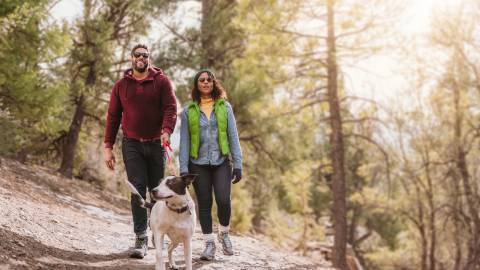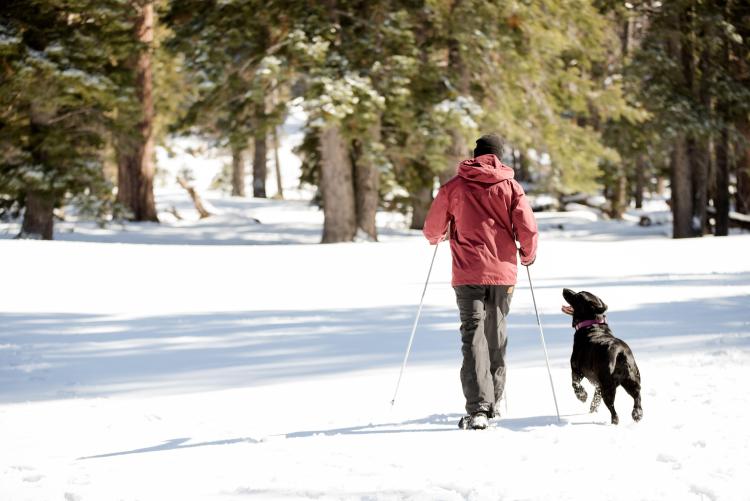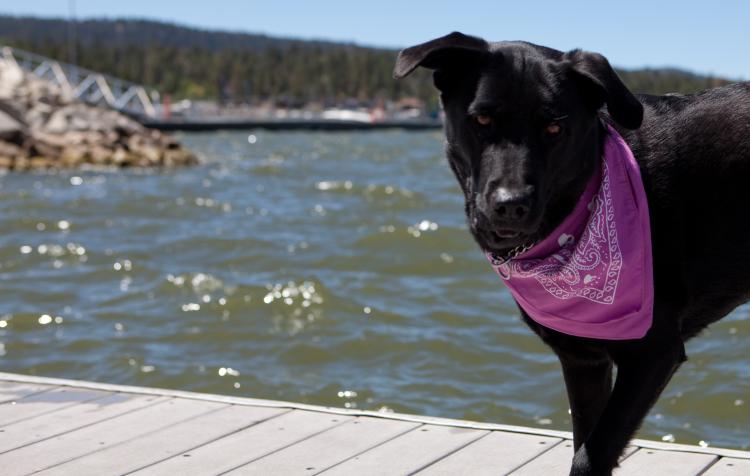
Pet Safety in Big Bear Lake
Posted: 11/20/24
Your dog can be the perfect companion on your vacation in Big Bear Lake, but be sure your getaway is safe for you and your dog.
Exposure to the sights and smells of the wilderness is invigorating and plays to your dog’s natural instincts. However, it's important to remember that dogs don't handle heat, cold, and exercise the same way humans do. Read FAQs on dog safety.
Pet Safety in the Winter
Winters can be frigidly cold for your dog. Even with a heavy fur coat, some colder temperatures may be too much for your pup to handle, especially for extended periods.
Monitoring Your Dog's Temperature
How do I know if my dog is too cold?
A simple rule of thumb is...If you feel cold, your dog does too. Once temps drop and ice and snow form, be careful and consider this:
- Paws in the snow and ice get cold very fast. Even thick-coated dogs who love the snow are probably not conditioned for the cold weather.
- Small dogs should wear coats or sweaters outside to keep warm.
- Booties are a good idea if you are walking your pets where there’s ice or snow.
- Use only pet-safe ice melt for defrosting your sidewalks and patios. Many de-icers contain salts that are harmful to your pet if licked. Be sure to clean off your dog's feet to prevent ingestion of toxins.
- Never leave your dog in the car!
How long in the cold is too long for my dog?
Even if your dog seems to enjoy the cold weather, there’s such a thing as too much of a good thing. Ultimately, it’s a judgment call — yours. When it gets too cold for you to tolerate, the same applies to your dog.
Other Considerations
Just like humans, dogs can slip and fall on ice and snow. Veterinarians see many torn ligaments in the winter and often the treatment requires surgery. It's best to keep your pet on a leash while outside and avoid buildups of ice where they can slip. If your dog is arthritic, keep in mind that it may be more difficult for him to move around in the winter. Be sure to make it easy for him to walk outside. Never leave your dog in your car!

Pet Safety in the Summer
Big Bear Lake's high altitude drains your energy - and your dog's energy - more quickly, triggering dehydration and exhaustion more easily. When taking your dog on hikes or walks in Big Bear, plan for additional water breaks.
While Big Bear summer temps tend to be mild, temperatures above 75 F degrees can become dangerous quickly. Dogs are more susceptible to heat exhaustion and hot surfaces like asphalt can burn your dog's paw pads. Plan your summertime jaunts during cooler temps in the mornings and later afternoons, and carry LOTS of water. Never leave your dog in your car!
If your dog sits down and refuses to continue, they are long overdue for a break. Take the time to move them into a shady area and cool them off with water. Let them decide when they are ready to continue. Knowing the symptoms of heat exhaustion in your dog are crucial. Keep an eye on:
- excessive panting
- dry/pale gums
- increased salivation
- rapid pulse
- weakness
- vomiting

FAQs on Dog-Friendly Big Bear
1. Is it safe for dogs to swim in Big Bear Lake?
While dogs are welcome to play and swim along the shoreline of Big Bear Lake, it's important to monitor their fun. Keep an eye on how far they're swimming and be sure they can safely return to shore. Never let your dog drink the lake water or scum along the shorelines. Always rinse off your dog once their water play time is over. Do not allow your dog to swim in the lake from late fall to late spring as temperatures are dangerously cold.
2. Where can I walk my dog in Big Bear?
Big Bear neighborhoods are always a great spot for a morning stroll with your dog, just remember to pick up after them along the way. Big Bear trails are also open to dogs year-round but it's important to keep an eye on your surroundings. Keep your dog leashed and don't allow them to chase wildlife as bites and injuries can occur. Be aware that summers are an active period for rattlesnakes; do not allow your dog to stick their nose in holes or other areas where snakes may be present. Please pick up after your dog.
3. What Activities are Dog Friendly in Big Bear?
Most outdoor recreation activities are dog friendly in Big Bear. Dogs are welcome to join you on your boat, kayak, or paddleboard on the lake. Many dogs also make good hiking buddies on the trails (see Pet Safety info above). And, dogs are always allowed in The Village, Big Bear's downtown shopping and dining hub. Read here for a list of pet-friendly restaurants in Big Bear Lake.
4. Where can my dog play in the winter snow?
We all know dogs love snow, but where are the safest places for them to play in Big Bear? Firstly, we recommend a fenced yard where they are safely away from traffic. If you don't have this, Big Bear features two dog parks in the valley Bark Park Big Bear Lake and Bark Park The Ranch.
5. What are the most important things to remember about bringing my dog to Big Bear?
Proper etiquette of your dog is your responsibility in your accommodations, at restaurants, in stores, at the lake, and on the trails. No matter where in Big Bear you are, always carry a supply of poop bags, a collar with ID tags and a sturdy 6-foot leash, water supply and a portable water bowl, a pet first aid kit, pet-safe insect repellent, a dog life vest for added swimming safety, dog booties for hiking in rough terrain and on hot asphalt.